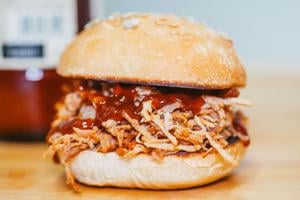The secret to making mouth-watering & tender pulled pork in your kitchen

Twenty years ago, Roanoke didn’t have a lot of restaurants where you could find made-in-house pulled pork. Aside from The Coffee Pot on Brambleton Avenue, which has served a righteous version of the low-country delicacy for decades, not many local eateries bothered to invest in industrial-scale outdoor smokers.
But in recent years we’ve seen a number of smokehouse-type joints open in the Roanoke Valley. And now there are plenty that serve mouth-watering, prepared-on-site, smoky meats.
One is Mama Jean’s Barbecue & Soulful Sides, which is located in an old Airstream trailer outside a house. It’s across from The Honey Baked Ham Co., which is on Broadway Avenue, just off Colonial Avenue. (My wife thinks Mama Jean’s smoked potato salad is the best she’s ever tasted.)
Canale’s Ham & BBQ, located in Grandin Gardens near the Raleigh Court Post Office, serves fantastic pulled pork and other meets, too. Mission BBQ, which is part of a smokehouse chain, has thrived at Towers shopping center on the side facing Colonial Avenue.
Due South BBQ, which launched in Christiansburg 15 years ago, now has a Roanoke outpost, in a former Country Cookin’ location along Melrose Avenue. Probably, there are others I haven’t mentioned. Sadly, TJ’s Backyard BBQ on Melrose Avenue closed early this year. It was one of the ‘Noke’s best-kept secrets.
I’ve bought pulled pork from all the above and more. It’s all great — except for the prices. Have you checked those lately? It’s not unheard of for a pound of that smoky goodness to set you back $13 or $14. (Roughly, a pound of pulled pork will fit in a pint container.)
Today, we’re sharing a far less costly do-it-yourself recipe. It’s a process I’ve been perfecting for years. It doesn’t require a $1,200 Big Green Egg smoker. While those are fantastic, they might not be a wise investment if you’re going to make pulled pork only a few times per year.
All you really need is an oven, a roasting pan with a rack, a handful of spices and the right cut of meat. With a bit of patience, you can feast on delicious pulled pork for a pittance of what it costs in a restaurant. It’s a wildly popular entre to bring to any summer potluck.
The finished product won’t be as smoky as the Real McCoy — because it’s not smoked. But it’s so good you might not even notice. Basically, all you need to do is rub meat with spices then slow roast it in your oven for about 16 hours and dress it with sauce. Read on for the details.
The first necessity is the correct cut of meat. For pulled pork, nothing will do besides a Boston butt. That’s a huge and fatty hunk of shoulder roast — not to be confused with its cousin, the pork picnic roast. The Boston butt has a big blade-shaped bone embedded within. Typically, they’re labeled “Boston butt” in the meat section.
Generally Boston butts range in weight from 6 to 12 pounds. And usually, the bottom is a thick slab of fat — this is known as the “fat cap.” (That’s important for later on.)
Lately, Boston butts have been selling in the $2 to $2.50 per-pound range. But scouring the grocery stores this summer, I realized both Kroger and Food Lion periodically put them on sale for 99 cents a pound. That’s a heckuva deal, and it seems to crop up about once per month. But you have to keep your eyes on the supermarket ads.
When you’re ready to cook, the first step is making the rub. That’s key to a lot of the flavor you’ll enjoy later. Here’s the recipe I use on mine — which I found on the internet some years ago.
1/4 cup paprika (regular or smoked);
2 tablespoons black pepper;
2 tablespoons chili powder;
2 tablespoons ground cumin;
2 tablespoons brown sugar;
2 tablespoons white sugar;
1 tablespoon cayenne pepper;
2 teaspoons ground mustard.
Wear disposable gloves while mixing those spices. (If you don’t, be careful not to touch your eyes.)
Stir all those together in a bowl, using a fork to break up clumps of brown sugar. It’ll make roughly a pint of rub, which is sufficient to season the biggest Boston butt you can buy. For the meantime, set aside the rub. (I often double this recipe and save half for the next time.)
You also want to prepare your sauce. There are plenty of those; one of the simplest is this eastern North Carolina recipe:
1 pint apple cider vinegar;
2-3 tablespoons of red pepper flakes; and
3 tablespoons of liquid smoke seasoning.
Mix those together and set aside for later, too.
Next, get out your roasting pan and rack. Lay a sheet of aluminum foil in the pan’s bottom and put the rack above it. (The foil makes clean-up a cinch.) Pre-heat your oven to 210 degrees.
Open your Boston Butt in the kitchen sink. Give it a good cold-water rinse and pat it dry with paper towels. If you haven’t already donned latex or nitrile disposable gloves, this is a good time. Otherwise the rub will stain your hands.
Wearing gloves, put the raw roast on a cutting board and apply the rub. The goal is a thick layer of spices sticking to the muscle and fat all the way around. Using your finger, push the rub into all the roast’s folds, nooks and crannies, too.
Once it’s covered in spices, put the roast in the rack with the fat cap UP. This is important, because you want all that wonderfully flavorful fat to leach into and through the roast as it’s rendered into the pan’s bottom. (If you have extra rub, just throw it on top of the fat cap.)
Plan on roasting for about 16 hours. I usually put my rubbed Boston Butt into the oven at midnight the night before we’re going to eat it. (By the next morning, the spices have begun blackening into a flavorful crust, and the whole house is overwhelmed with a tantalizing aroma.)
The key is to cook the roast very slowly until it reaches at least 180 degrees. For this reason, I use a probe-type thermometer with a wire that leads to a temperature indicator outside the oven.
When that hits 180-183 degrees, the roast is ready to come out — but it’s hardly finished cooking. Instead, you need to wrap it in heavy-duty aluminum foil for an hour. I use two large sheets of foil, and stash the wrapped roast in a small cooler, where it stews in its own juices.
During that hour is a good time to drain and wash the roasting pan, which you’ll use again later.
After the hour’s up, unwrap the roast in the pan. The pork will be so tender that the blade-shaped bone should slide out easily. It and the foil go in the trash.
Next, shred or “pull” apart the meat using two forks, moving them in opposite directions. You can also use implements known as Bear Claws, which are specifically made for pulling pork. My kids gave me a pair for Christmas a few years ago, and they’re wonderful.
After the pork is shredded, add the earlier-prepared sauce, which has natural smoke-seasoning embedded in it. Stir it well into the meat shreds and voila! The result is delicious pulled pork that’s ready to serve.
If you made it from a 99-cents-per-pound Boston butt, your total outlay including spices will be under $2 per pound. That’s far less expensive than the actually smoked stuff at restaurants, and pretty close to the Real McCoy.
And because many people like their shredded pork with coleslaw, here’s a recipe for southern slaw that perfectly complements the entre:
1 pound shredded cabbage (or bag of coleslaw mix);
1 medium onion, thinly sliced;
1/2 cup extra virgin olive oil;
celery seed (not celery salt).
To make the slaw, put the shredded cabbage and sliced onion in a large bowl. In a saucepan, mix the oil, vinegar and sugar and bring to a boil. After the sugar is dissolved, slowly pour the hot liquid over the cold cabbage and onion, while stirring. Then sprinkle on the black pepper and celery seed. I used a lot of each.
After just a couple of hours in your fridge, the cabbage and onion will wilt and make for a tasty, tangy mayonnaise-free slaw.
Put some on your plate with a pile of DIY pulled pork, and add some fresh sliced tomatoes and an ear of sweet corn.
That’s a heckuva summer dinner. Enjoy!




